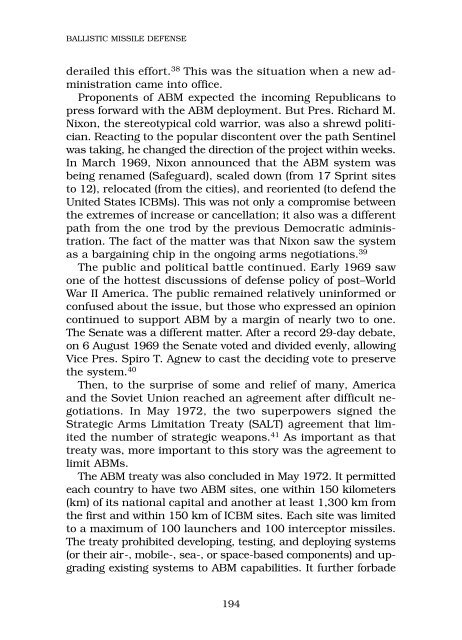Archie to SAM: A Short Operational History of Ground-Based Air ...
Archie to SAM: A Short Operational History of Ground-Based Air ...
Archie to SAM: A Short Operational History of Ground-Based Air ...
Create successful ePaper yourself
Turn your PDF publications into a flip-book with our unique Google optimized e-Paper software.
BALLISTIC MISSILE DEFENSE<br />
derailed this effort. 38 This was the situation when a new administration<br />
came in<strong>to</strong> <strong>of</strong>fice.<br />
Proponents <strong>of</strong> ABM expected the incoming Republicans <strong>to</strong><br />
press forward with the ABM deployment. But Pres. Richard M.<br />
Nixon, the stereotypical cold warrior, was also a shrewd politician.<br />
Reacting <strong>to</strong> the popular discontent over the path Sentinel<br />
was taking, he changed the direction <strong>of</strong> the project within weeks.<br />
In March 1969, Nixon announced that the ABM system was<br />
being renamed (Safeguard), scaled down (from 17 Sprint sites<br />
<strong>to</strong> 12), relocated (from the cities), and reoriented (<strong>to</strong> defend the<br />
United States ICBMs). This was not only a compromise between<br />
the extremes <strong>of</strong> increase or cancellation; it also was a different<br />
path from the one trod by the previous Democratic administration.<br />
The fact <strong>of</strong> the matter was that Nixon saw the system<br />
as a bargaining chip in the ongoing arms negotiations. 39<br />
The public and political battle continued. Early 1969 saw<br />
one <strong>of</strong> the hottest discussions <strong>of</strong> defense policy <strong>of</strong> post–World<br />
War II America. The public remained relatively uninformed or<br />
confused about the issue, but those who expressed an opinion<br />
continued <strong>to</strong> support ABM by a margin <strong>of</strong> nearly two <strong>to</strong> one.<br />
The Senate was a different matter. After a record 29-day debate,<br />
on 6 August 1969 the Senate voted and divided evenly, allowing<br />
Vice Pres. Spiro T. Agnew <strong>to</strong> cast the deciding vote <strong>to</strong> preserve<br />
the system. 40<br />
Then, <strong>to</strong> the surprise <strong>of</strong> some and relief <strong>of</strong> many, America<br />
and the Soviet Union reached an agreement after difficult negotiations.<br />
In May 1972, the two superpowers signed the<br />
Strategic Arms Limitation Treaty (SALT) agreement that limited<br />
the number <strong>of</strong> strategic weapons. 41 As important as that<br />
treaty was, more important <strong>to</strong> this s<strong>to</strong>ry was the agreement <strong>to</strong><br />
limit ABMs.<br />
The ABM treaty was also concluded in May 1972. It permitted<br />
each country <strong>to</strong> have two ABM sites, one within 150 kilometers<br />
(km) <strong>of</strong> its national capital and another at least 1,300 km from<br />
the first and within 150 km <strong>of</strong> ICBM sites. Each site was limited<br />
<strong>to</strong> a maximum <strong>of</strong> 100 launchers and 100 intercep<strong>to</strong>r missiles.<br />
The treaty prohibited developing, testing, and deploying systems<br />
(or their air-, mobile-, sea-, or space-based components) and upgrading<br />
existing systems <strong>to</strong> ABM capabilities. It further forbade<br />
194
















